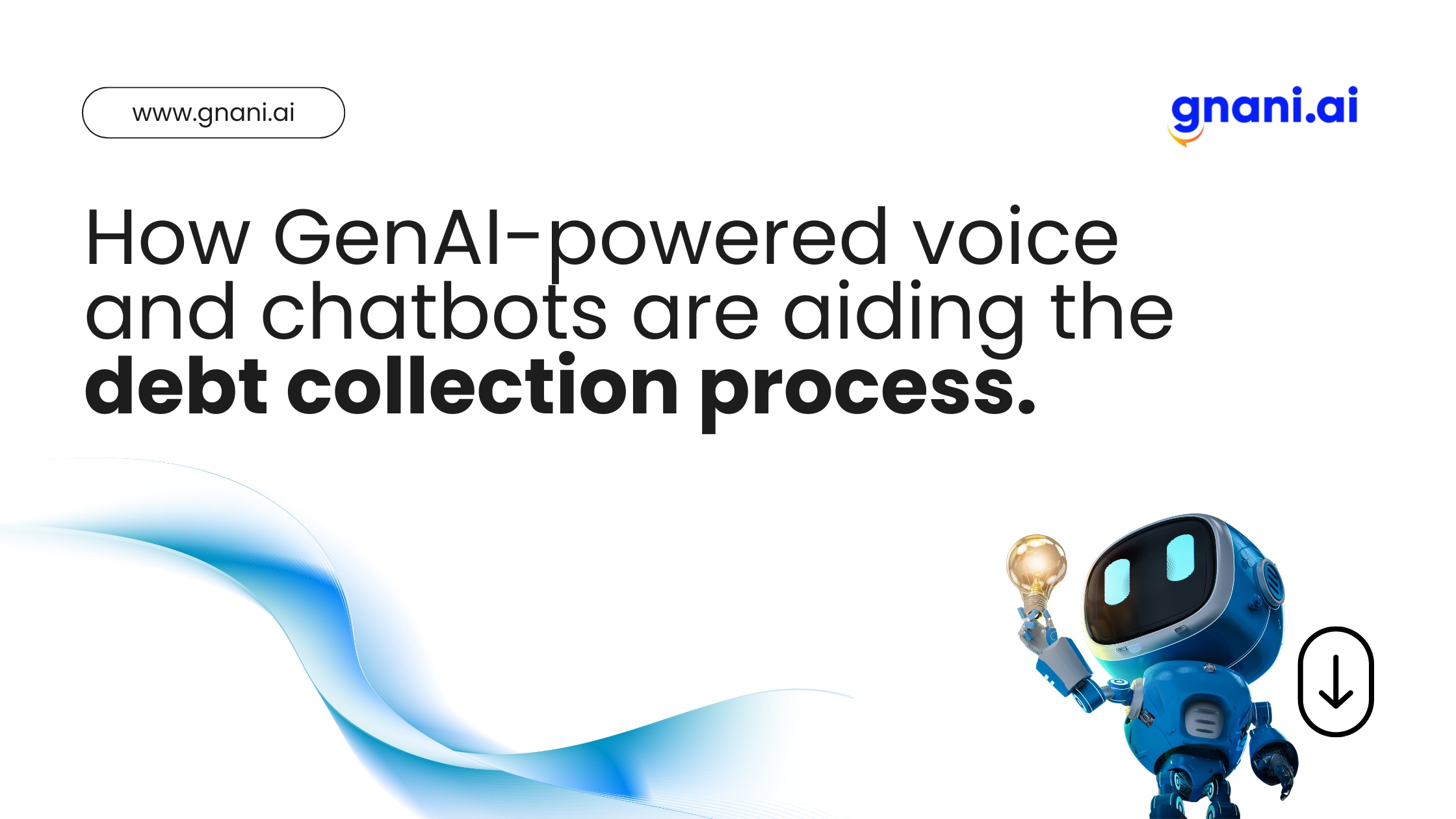Gen AI in Banking is revolutionizing the way debt collection is handled. In the banking sector, debt collection has traditionally been a complex and often frustrating process. With methods ranging from repeated phone calls to generic SMS reminders and third-party collection agencies, the process has often led to inefficiencies and customer dissatisfaction. However, with advancements in Generative AI and Conversational AI, the landscape of debt collection is undergoing a significant transformation, and innovative solutions are leading the way.
Personalized Communication: The New Standard
One of the major challenges in debt collection is determining the most effective way to communicate with each customer. Modern Conversational AI systems analyse customer data to select the optimal communication channel—whether it’s SMS, voice bots, or messaging apps like WhatsApp. This tailored approach ensures that each customer receives relevant and timely communication, improving engagement and payment rates.
Forrester Research reports that businesses leveraging AI for personalization experience, see engagement rates increase by up to 70%. Advanced technologies such as Google Dialogflow and Microsoft Azure Cognitive Services enable these tailored communication strategies, leading to better customer responses and efficient collections.
Reducing Over-communication: A More Efficient Approach
Traditional debt collection methods often result in over-communication, where customers receive multiple reminders even after they’ve taken action. Modern AI-driven systems address this issue by monitoring real-time responses. Once a payment is made or a response is received, the system automatically halts further communication, reducing customer frustration and lowering operational costs. Such systems also ensure that henceforth, this customer will be reached out on the channel that has been most efficient in terms of connectivity and collection.
Implementing such systems has resulted in a 30% reduction in customer complaints for many organizations. Technologies like Apache Kafka and AWS Lambda support real-time processing, ensuring that communication is efficiently managed.
Boosting Efficiency Through Automation
Debt collection involves many repetitive tasks that can drain resources. Conversational AI addresses this by automating routine tasks such as sending reminders and follow-up messages. This automation speeds up the collection process and allows human agents to focus on more complex issues.
Automating these tasks can lead to a 50% reduction in operational costs and faster collection times. Platforms utilizing IBM Watson and Pega Systems are streamlining operations, enhancing efficiency across the board.
Data-Driven Insights for Strategic Improvement
Conversational AI systems gather and analyze large volumes of customer data, providing valuable insights for refining collection strategies. By understanding which channels and timings are most effective, banks can continually improve their approaches to debt collection.
Advanced analytics tools like Python’s Scikit-Learn, H2O.ai, and Tableau help in analyzing customer interactions, leading to a 20% improvement in recovery rates(McKinsey). This data-driven approach enables banks to optimize their collection strategies based on actionable insights.
Revolutionizing Debt Collection: How Gnani.ai’s Collect365 Enhances Efficiency and Effectiveness
To address the complexities of debt collection, Gnani.ai offers Collect365, a product designed to enhance the efficiency and effectiveness of collection strategies. Collect365 leverages AI to build dynamic, data-driven strategies across multiple communication channels—SMS, voice calls, WhatsApp, and email.
-
- AI-Driven Strategy Building: Collect365 harnesses the power of AI to craft dynamic, data-driven collection strategies. By analyzing customer data and interactions, the platform identifies the most effective communication channels—whether SMS, voice calls, WhatsApp, or email—to ensure that outreach is personalized and relevant.
- Multi-Channel Integration: The platform integrates multiple communication channels into a unified system. This integration allows banks to manage and execute their collection strategies seamlessly across various platforms, improving overall efficiency and reducing the need for disparate systems.
- Real-Time Response Management: Collect365 features an advanced real-time response management system. It intelligently monitors customer interactions and automatically adjusts communication efforts based on real-time feedback. This functionality helps prevent over-communication, reducing customer frustration and enhancing their overall experience.
- Customizable Strategy Builder: One of the key features of Collect365 is its strategy builder. This tool enables banks to design and implement customized communication plans based on historical data and customer behavior patterns. The ability to tailor strategies ensures more effective collections and contributes to cost savings by optimizing communication efforts.
- AI-driven Insights: With advanced AI and analytics capabilities, Aura 365 can gather valuable insights from customer interactions. This data can help organizations improve their service offerings, understand customer needs better, and personalize future interactions.
Collect365 not only streamlines the debt collection process but also helps banks to achieve a more efficient, customer-centric approach, ultimately leading to improved recovery rates and reduced operational costs.
The Future of AI in Debt Collection
As Conversational AI continues to advance, several exciting developments are on the horizon:
-
- Predictive Outreach: Future AI systems will predict when customers might face payment difficulties and proactively reach out with tailored reminders. Predictive models could reduce overdue accounts by 30% (Forbes).
- Omni-Channel Integration: AI will enhance its ability to manage communications seamlessly across multiple channels. Unified solutions will allow banks to handle SMS, voice, email, and chat from a single platform, improving communication efficiency (Gartner).
- Enhanced Customer Profiling: Advances in AI will enable detailed customer profiles for hyper-personalized communication. This approach aims to improve both debt collection effectiveness and customer relationships (Business Insider).
- AI-Powered Negotiation: Real-time AI negotiation tools could facilitate flexible payment plans, reducing the burden on human agents and providing immediate solutions to customers (Entrepreneur.com).
Conclusion: Embracing the Future of Banking with AI
Conversational AI is leading the charge in revolutionizing debt collection as the financial sector undergoes a digital transformation. AI is reshaping the future of collections by automating processes, reducing costs, and improving customer experiences.
The continued evolution of Conversational AI promises even greater innovations, creating a more efficient and customer-centric approach to debt collection. As technology advances, the future of debt collection is becoming smarter, more effective, and more attuned to the needs of both banks and their customers.



AI Debt Recovery Agents: Revolutionizing Collections
[…] Gen AI in Banking: Automating Debt collection with AI Agents – Gnani.ai – https://www.gnani.ai/resources/blogs/gen-ai-in-banking-automating-debt-collection-with-ai-agents/ […]